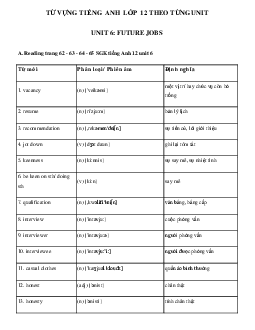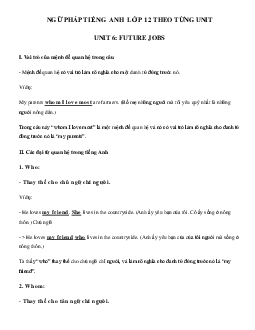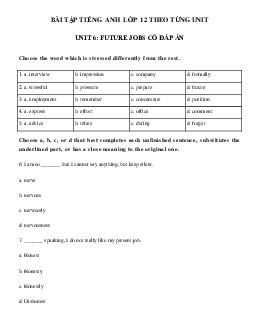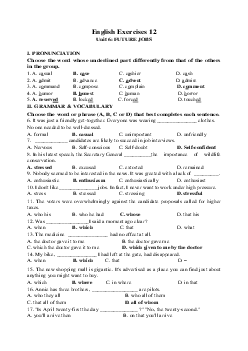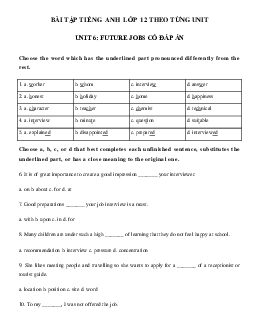











Preview text:
Pronunciation - trang 5 Unit 6 Sách Bài Tập (SBT) Tiếng anh 12 mới
1. Read the following exchanges. Decide and underline where the linking /r/ is likely to happen in fast, connected speech.
Đọc các trao đổi dưới đây. Quyết định và gạch gưới nơi mà liên âm /r/ có khả năng diễn ra trong văn nói nhanh, liền mạch. Đáp án:
2. Practice the exchanges in 1.
Luyện tập các trao đổi trong bài 1.
Vocabulary & Grammar - trang 6 Unit 6 Sách Bài Tập (SBT) Tiếng anh 12 mới
1. Complete the following table. (Hoàn thành bảng dưới đây) Đáp án:
1. dangerous, endangered (adj) / endanger (v)
2. extinction (n) / extinct (adj) 3. evolution (n) / evolve (v)
4. diverse (adj) / diversify (v) 5. poacher (n) 6. vulnerable (adj)
2. Choose the words from the completed table in to complete these sentences. Make changes to
the word forms where necessary. (Chọn các từ trong bảng đã hoàn thành để hoàn thành các câu. Thay
đổi hình thức từ những chỗ cần thiết.) 1.
Many people think the money spent on protecting__________species should be used for
improving the lives of the local people. 2.
Animals classified as CR on the conservation status scale are in danger of__________ . 3.
Old people and children are particularly__________ to lung diseases in the cold weather. 4.
Elephants are usually ___________ for their tusks, while rhinos are killed for their horns. 5.
This river used to have the greatest__________ of freshwater fish in the country, but now very few species are found here. 6.
The new__________ theory has combined Darwin's theory of natural selection with genetic
factors to explain how__________occurs. Đáp án:
1.endangered: Nhiều người nghĩ rằng số tiền chi cho việc bảo vệ các loài quý hiếm cần được sử dụng để
cải thiện cuộc sống của người dân địa phương.
2. extinction: Loài vật được phân loại là CR trên diện hiện trạng bảo tồn đang có nguy cơ tuyệt chủng
3. vulnerable: Người già và trẻ em đặc biệt dễ bị bệnh phổi trong thời tiết lạnh.
4 . poached: Voi thường bị săn bắn để lấy ngà, trong khi con tê giác bị giết để lấy sừng.
5. diversity: Con sông này từng có sự đa dạng lớn nhất của loài cá nước ngọt trong nước, nhưng bây giờ
rất ít loài được tìm thấy ở đây.
6. evolutionary, evolution: Lý thuyết tiến hóa mới đã kết hợp thuyết chọn lọc tự nhiên với các yếu tố di
truyền của Darwin để giải thích tiến hóa xảy ra như thế nào.
3. Below are an environmentalist's notes, predicting how the world will have changed by the year
2040. Use the notes to write sentences in the future perfect tense. The first one has been done for
you. (Dưới đây là những ghi chú của một nhà môi trường học, dự đoán cách thế giới sẽ thay đổi vào
năm 2040. Sử dụng các ghi chú để viết câu ở thì tương lai hoàn thành. Câu đầu tiên đã được thực hiện cho bạn.) Gợi ý trả lời:
2. climate change will have caused many areas in the world to be under sea level. biến đổi khí hậu sẽ
biến nhiều khu vực trên thế giới ở dưới mực nước biển.
3. rhinos will have become totally extinct. tê giác sẽ trở nên hoàn toàn tuyệt chủng.
4. sea turtles will have restored their population level thanks to human efforts. rùa biển sẽ phục hồi mức
độ dân số của chúng nhờ vào những nỗ lực của con người.
5. we will have replaced energy generated from fossil fuels with wind and sun power. chúng ta sẽ thay
thế năng lượng được tạo ra từ nhiên liệu hóa thạch bằng gió và năng lượng mặt trời.
6. pollution problems will have been effectively solved in many countries. vấn đề ô nhiễm sẽ được giải
quyết một cách hiệu quả ở nhiều nước.
4 Complete the sentences with appropriate words from the box. A word can be used more than
once. (Hoàn thành câu với những từ ngữ thích hợp trong hộp. Một từ có thể được sử dụng nhiều hơn một lần.)
more less faster better harder higher stricter 1.
The ________ you water this plant, the ________it will grow. 2.
The ________ fast food you eat, the ________healthy you might become. 3.
The ________ our laws against poaching are, the ________ chances there are for endangered animals to survive. 4.
The ________ the demand for ivory products is, the ________ the number of elephants falls. 5.
The ________ you study for the exam, the ________ your scores will be. Đáp án:
1. more ... faster/better: Bạn càng tưới cây này nhiều, nó sẽ càng lớn nhanh
2. more ... less: Bạn càng ăn nhiều đồ ăn nhanh, bạn có thể càng trở nên kém khoẻ mạnh hơn
3. stricter... more: Luật của chúng ta càng nghiêm khắc đối với hành vi săn bắt trộm, càng có nhiều cơ
hội cho động vật quý hiếm sống sót
4. higher... faster: Nhu cầu về sản phẩm từ ngà voi càng cao, số lượng voi bị giết càng nhanh
5. more/harder... higher/better: Bạn càng học chăm chỉ cho kì thi, điểm của bạn sẽ càng cao.
5. Each of the following sentences has one mistake. Underline the mistakes and write the
corrections in the spaces provided. (Mỗi câu sau đây có một lỗi sai. Gạch dưới những lỗi sai và
viết những chỉnh sửa ở chỗ được cung cấp.) 1.
I'll wait for you here until you will have finished your work. 2.
The faster you drive, it becomes more dangerous. 3.
By the time we will have got to the conference about wildlife protection, the opening speech have started. 4.
The more severe climate change becomes, the more serious wildlife is affected. 5.
More people move to the city, the higher the cost of living there gets. Đáp án:
1. will have finished -> have finished
2. it becomes more dangerous -> the more dangerous it becomes
3. will have got -> get
4. serious -> seriously 5. More -> The more
Reading - trang 8 Unit 6 Sách Bài Tập (SBT) Tiếng anh 12 mới
1. Read the first part of the text about elephants and fill each gap with a word from the
box. (Đọc phần đầu của văn bản về voi và điền vào mỗi khoảng cách với một từ từ hộp.) endangered seeking abundant wild dedicated declining
The 12th of August is World Elephant Day, which is an international annual event (1) ________ to the
preservation and protection of the world's elephants. Why is there a day for elephants? The answei can
be found in the fact that this species' population is rapidly (2) ________ , and they need help.
In 1930, there were about 10 million African elephants in the wild. In 1989, when they were added to
the international list of the most (3) ________ species, there were about 600,000 remaining. Elephant
numbers have dropped by 62% over the last decade, and they could be mostly extinct by the end of the
next decade. An estimated one hundred African elephants are killed each day by poachers (4) ________
ivory, meat, and body parts, leaving only 400,000 alive today.
Asian elephants have never been as (5) ________as African ones, and today they are even more
endangered. At the turn of the century, there were an estimated 200,000 Asian elephants. Today there
are probably no more than 40,000 in the (6) ________. Đáp án:
1. dedicated 2. declining 3. endangered
4. seeking 5. abundant 6. wild Dịch:
ngày 12 tháng 8 là ngày Voi thế giới, đó là một sự kiện thường niên quốc tế dành riêng cho việc bảo
tồn và bảo vệ loài voi trên thế giới. Tại sao lại có một ngày cho loài voi? Câu trả lời có thể được tìm
thấy trong thực tế là dân số loài này đang suy giảm nhanh chóng, và chúng cần sự giúp đỡ.
Năm 1930, đã có khoảng 10 triệu voi Châu Phi ở trong hoang dã. Năm 1989, khi chúng đã được
thêm vào danh sách quốc tế của các loài bị đe dọa nhất, đã có khoảng 600.000 còn lại. số voi đã giảm
62% trong thập kỷ qua, và chúng có thể hầu hết bị tuyệt chủng vào cuối thập kỷ tiếp theo. Ước tính có
khoảng một trăm con voi châu Phi bị giết mỗi ngày bởi những kẻ săn trộm tìm ngà voi, thịt, và các bộ
phận cơ thể, chỉ để lại 400.000 sống sót ngày nay.
Voi châu Á chưa bao giờ phong phú như châu Phi, và ngày nay chúng thậm chí còn bị đe dọa nhiều
hơn. Vào đầu thế kỷ này, ước tính có khoảng 200.000 voi châu Á. Ngày nay có lẽ không
quá 40.000 trong tự nhiên.
2. Read the second part of the text and answer the questions. (Đọc phần thứ hai của văn bản và trả lời các câu hỏi.)
Elephants are a keystone species, and they play an important role in maintaining biodiversity. Below are some examples.
While looking for food, elephants pull down trees and break up thorny bushes, which helps to create
grasslands for other animals to inhabit. In addition, they use their feet to dig up salt licks that are rich in
nutrients for themselves and for other animals. Their footprints also create deep holes that water can
collect in. Other species rely on this water source in the dry season.
Most importantly, elephant droppings are vital to the environment. Animals such as baboons and birds
pick up undigested seeds and nuts from these droppings for their food. This type of waste also works as
a kind of manure, which helps humans to have fertile soil to plant their crops. Elephant droppings are
also a vehicle for dispersing seeds and making them grow. Some types of seeds will not germinate
unless they have passed through an elephant's digestive system. So, if elephants become extinct, those
seeds would not grow into trees, leading to an increase in soil erosion and flooding.
What would happen if there were no more elephants on Earth? Elephants maintain the ecosystems in
which they live, and make it possible for a lot of other plant and animal species to survive in those
environments as well. In a nutshell, if elephants become extinct, many other species will disappear. 1.
How can elephants create grasslands for other animals to live in? 2.
Where do many species get water in the dry season? 3.
Where do baboons and birds get their food? 4.
In what way can humans benefit from elephants? 5.
How can elephant droppings affect the growth of some kinds of seeds? 6.
What happens if elephants become extinct? 7.
Where are the two parts of the text above most likely to be found: in a brochure for wildlife
protection, or a scientific report about the importance of elephants? Đáp án:
1 . They create grasslands when they pull down trees and break up thorny bushes while looking for
food. Chúng tạo ra đồng cỏ khi chúng quật ngã cây và phá vỡ các bụi cây gai góc trong khi tìm kiếm thức ăn.
2. They get water that is collected and stored in deep holes created by elephants' footprints. Chúng lấy
nước đã được thu thập và chứa trong các hố sâu được tạo ra bởi những dấu chân voi
3. Baboons and birds get their food from undigested seeds and nuts in elephant droppings. Khỉ đầu chó
và chim có được thức ăn từ hạt không tiêu hóa được và các loại hạt trong phân voi.
4. Humans can have rich soil which is fertilised by elephant droppings. Con người có thể có đất màu
mỡ mà đã được vun bồi thêm bởi phân voi.
5. Some kinds of seeds cannot grow into trees naturally. They can germinate only after passing through
an elephant's digestive system. Một số loại hạt không thể phát triển thành cây tự nhiên. Chúng có thể nảy
mầm chỉ sau khi đi qua hệ tiêu hóa của một con voi.
6. If elephants become extinct, there will be fewer trees, leading to soil erosion and flooding, and many
other species will disappear. Nếu voi bị tuyệt chủng, sẽ có ít cây hơn, dẫn đến xói mòn đất và lũ lụt, và
nhiều loài khác sẽ biến mất.
7. (Suggested answer) In a brochure for wildlife protection. The rhetorical questions (e.g. Why is there c
day for elephants? What would happen if there were no more elephants on Earth?) are used to persuade
or influence readers. These questions do not really ask for the answers; they serve to emphasise a point
or just get the audience thinking.
(Câu trả lời gợi ý) Trong một cuốn sách nhỏ về bảo vệ động vật hoang dã. Các câu hỏi tu từ (ví dụ Tại
sao lại có một ngày cho voi? Điều gì sẽ xảy ra nếu không có nhiều voi trên trái đất?) được dùng
để thuyết phục hoặc tác động đến độc giả . Những câu hỏi này không thực sự yêu cầu cho câu trả
lời; chúng dùng để nhấn mạnh một điểm, hoặc chỉ nhận những suy nghĩ của khán giả.
3. Find the words or phrases from the two parts of the text which mean the following: (Tìm các
từ hoặc cụm từ từ hai phần của văn bản mà có nghĩa như sau:) 1.
(of number) calculated approximately, but not exactly
tính toán xấp xỉ, nhưng không chính xác 2.
existing in large quantities; numerous
có sẵn với số lượng lớn; nhiều 3.
the most important part (of a plan,idea, etc.) that other parts depend on
phần quan trọng nhất (của một kế hoạch, ý tưởng, vv) mà các bộ phận khác phụ thuộc vào 4.
a place to which animals go to take in salt deposits
một nơi mà động vật thường đến liếm muối 5. spreading widely lan rộng 6.
dung; solid waste matter of animals
phân; chất thải rắn của động vật 7. in a few words; briefly
trong một vài từ; ngắn gọn Đáp án:
1. estimated 2. abundant 3. keystone 4. salt lick
5. dispersing 6. droppings 7. in a nutshell
Speaking - trang 10 Unit 6 Sách bài tập (SBT) Tiếng anh 12 mới
1. Read the information about how to protect red-crowned cranes and African elephan Choose
one species and complete note cards for a talk about its protection. (Đọc thông tin về làm thế nào để
bảo vệ sếu đầu đỏ và voi châu Phi. Chọn một trong loài và hoàn thành thẻ ghi chú cho một cuộc nói
chuyện về bảo vệ nó.)
A. Introduction (Giới thiệu)
- Good morning/afternoon, everyone. (Chào buổi sáng/Chào buổi chiều)
- Today, I'd like to talk about how to protect (red-crowned cranes/elephants), an endangered species.
(Hôm nay, tôi muốn nói về làm thế nào để bảo vệ (sếu đầu đỏ/voi), một loài động vật đang bị đe doạ.)
B .How to protect (species) (Làm sao để bảo vệ)
B1. To begin with, I'd like to suggest... (Để bắt đầu, tôi muốn đề nghị...)
B2. Let's now turn to another solution ... (Giờ hãy chuyển đến cách giải quyết khác...)
B3. My next point is ... (Quan điểm tiếp theo của tôi là...)
B4. One final way to protect (species) is... (Một cách cuối cùng để bảo vệ là...) C. Conclusion (Kết luận)
-To sum up, let's look at the main points again .... (Tổng kết, hãy nhìn lại những luận điểm một lần nữa..)
-Thanks for listening. (Cám ơn đã lắng nghe.)
2. Work in groups. Use the note cards to present your talk to your group members.
Làm việc nhóm. Sử dụng các thẻ ghi chú để trình bày bài nói của bạn trước thành viên trong nhóm của bạn.
Writing - trang 11 Unit 6 Sách Bài Tập (SBT) Tiếng anh 12 mới
1. Read the facts about the red-crowned crane and complete the table. (Đọc các dữ kiện về sếu đầu
đỏ và hoàn thành bảng.)
a. about 2,750 in the wild
khoảng 2.750 trong tự nhiên
b. prefer wetlands, rivers, swamps, and rice paddies for feeding
thích vùng đất ngập nước, sông, đầm lầy, và lúa gạo làm thức ăn
c. endangered (IUCN Red List)
bị đe dọa (Danh sách đỏ IUCN)
d. non-migratory cranes: on Hokkaido Island, Japan
sếu không di cư: trên đảo Hokkaido, Nhật Bản
e. weight: 7-10 kilos; height: 150 cm
trọng lượng: 7-10 kg; Chiều cao: 150 cm Đáp án: 1. d 2. e 3. b 4. a 5. c
2. Write a report of 150-200 words to describe the red-crowned crane, using the facts in . Follow
the plan and use the prompts below: (Viết một báo cáo trong 150-200 từ để miêu tả sếu đầu đỏ, sử
dụng các dữ kiện trong 1. Thực hiện theo kế hoạch và sử dụng các hướng dẫn dưới đây:) Gợi ý trả lời:
Red-crowned cranes are mostly found in north-east Asia. There are two kinds: migratory and
non-migratory. In autumn, the migratory ones migrate from their breeding grounds in Russia,
north-eastern China and Mongolia to Korea and coastal China.Then they fly back to their old ‘homes’ in
spring. Meanwhile, the non-migratory population lives on Hokkaido Island, Japan all year round.
This species is called red-crowned crane because they have a red patch of bare skin on the top of their
head. They are both land and water birds, and they prefer wetlands, rivers, swamps, and rice paddies for
feeding. A crane can be as tall as 150 centimetres and weighs 7 to 10 kilogrammes. Although they are
big, these birds just eat insects, fish and crabs during the breeding season. In winter, they eat vegetation like grass, nuts or rice.
There are about 2,750 red-crowned cranes in the wild. According to the IUCN Red List, red-crowned
cranes are classified as endangered because their population is decreasing. Their main threats come from
human activities: poaching, and agricultural and economic development. Their habitat is strongly
affected when people use pesticides in farming or build dams to store water, which lowers the water
level in lowland areas. There have been efforts to protect this species. Governments in many countries
promote breeding programmes with captive birds to increase the population of this fascinating species. Dịch:
Sếu đầu đỏ chủ yếu được tìm thấy ở Đông Bắc Á. Có hai loại: di cư và không di cư. Vào mùa thu, những
loài di cư di chuyển từ khu vực sinh sản của chúng ở Nga, Đông Bắc Trung Quốc và Mông Cổ đến Hàn
Quốc và duyên hải Trung Quốc. Sau đó chúng bay trở lại 'nhà' cũ của mình trong mùa xuân. Trong khi
đó, loài không di cư sống trên đảo Hokkaido, Nhật Bản quanh năm.
Loài này được gọi là sếu đầu đỏ bởi chúng có một miếng vá da trần màu đỏ trên đỉnh đầu của chúng.
Chúng là chim sống cả trên cạn và dưới nước, và chúng thích vùng đất ngập nước, sông, đầm lầy, và lúa
gạo làm thức ăn. Một con sếu có thể cao 150 cm và nặng 7-10 kg. Mặc dù chúng lớn, những con chim
này chỉ ăn côn trùng, cá và cua trong mùa sinh sản. Vào mùa đông, chúng ăn thực vật như cỏ, các loại hạt hoặc gạo.
Có khoảng 2.750 sếu đầu đỏ trong môi trường hoang dã. Theo Sách đỏ của IUCN, sếu đầu đỏ được phân
loại là bị đe dọa vì dân số của chúng đang giảm dần. mối đe dọa chính của chúng đến từ các hoạt động
của con người: săn trộm, và phát triển nông nghiệp và kinh tế. môi trường sống của chúng bị ảnh
hưởng mạnh khi người dân sử dụng thuốc trừ sâu trong nông nghiệp hoặc xây dựng các con đậpgiữ nước,
làm giảm mực nước ở các vùng đất thấp. Đã có những nỗ lực để bảo vệ các loài này. Các chính phủ ở
nhiều nước thúc đẩy các chương trình gây giống với loài chim nuôi nhốt để tăng dân số của loài hấp dẫn này.
